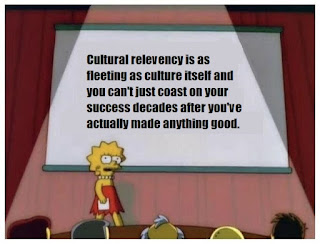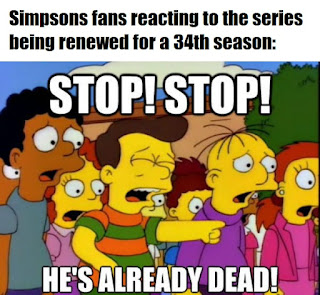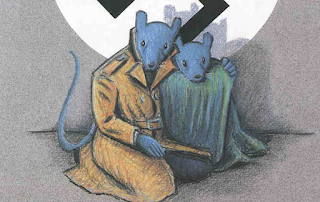The following article was originally written for and published by the Grand Geek Gathering on February 9th, 2022.
In recent weeks you’ve probably heard a lot about the graphic novel Maus being banned. In 1992, it became the first and only graphic novel to win a Pulitzer Prize.
The school board of McMinn County, Tennessee, unanimously voted on Jan. 10 to remove the book from the eighth-grade curriculum. The decision was made due to the book’s “rough, objectionable” language and a few images of nudity (including a few panels in which Auschwitz prisoners are stripped, and one where the author finds his mother dead in a bathtub from suicide).
Maus is the story of the author’s father, Vladek Spielgelmen, a Polish Jew and a Holocaust survivor. Framed as a series of interviews between the author, Art Spielgelman, and his father, the comic explores both Vladek’s experiences leading up to the war and his time in Auschwitz, as well as Art’s complicated relationship with him. In this way, the story isn’t merely about the tragedy of the Holocaust for the people who endured it but about its long-reaching effects on the children of survivors.
The story of Maus’s ban went viral, due in part due to Holocaust Remembrance Day falling a mere 17 days after the decision was made to pull the book from schools. A public outcry launched the book to Amazon’s best seller list and resulted in tens of thousands of donations of the book to libraries and book clubs.

One high school student's response to the school board regarding the removal of Maus.
On the heels of this controversy, in what was presumably a backlash to the backlash, a Tennessee church organized a book burning for popular YA titles that “promote witchcraft,” including Harry Potter and Twilight.
Now seems like a good time not only to snag a copy of Maus but to explore some other controversial titles. While the list of banned books is long, this article will focus specifically on graphic novels, ones that I believe hold similarities to Maus that make them both controversial and culturally important. If you haven’t already, check out the following.
Barefoot Gen by Keiji Nakazawa

What It’s About: Published as a serial between 1973 and 1987, Barefoot Gen (Hadashi no Gen) is a semi-autobiographical account of a Hiroshima survivor’s experiences in 1945.
Why It’s So Controversial: Told from the point of view of a 6-year-old boy, it’s been adapted into multiple movies (including a popular 1983 animation), but its depiction of post-war atrocities by Japanese soldiers resulted in a brief ban in some Japanese schools in 2012, which was later lifted.
Why You Should Read It: Like Maus, this book is a firsthand account of war experienced, and specifically the (literal) fallout of war as it impacted a child and a civilian. Especially for Americans, the devastating effects of the decision to drop a nuclear weapon on Japan in 1945 should be reflected on with a critical eye. Nakazawa’s widow, on the ban, stated: “War is brutal. [Barefoot Gen] expresses that in pictures, and I want people to keep reading it.” It’s worth noting that this manga influenced Art Spielgelman himself.
Persepolis by Marjane Satrapi

What It’s About: Another book focused on a child experiencing war, this graphic memoir tells of a 10-year-old girl’s coming-of-age during the Islamic revolution in Iran during the 1980s.
Why It’s So Controversial: Persepolis has sold over two million copies worldwide, and also snagged a top spot on ALA’s list of "Top Ten Most Challenged Books of 2014.” It doesn’t shy away from topics such as the main character’s budding sexual growth, nor of violence under the fundamentalist Islamic regime of Iran in the 1980s, including such imagery as a dismembered soldier and descriptions of torture.
Why You Should Read It: A complex depiction of cultural identity and feminism, this book challenges both Eastern and Western assumptions about freedom and expression. Satrapi’s exploration of her own Islamic and Iranian identity isn’t black-and-white; it challenges the idea that religious expression is inherently oppressive while also condemning state-sanctioned violence in the name of religion.
American Born Chinese by Gene Luen Yang

What It's About: Three interwoven stories explore cultural identity: one parable tells of the Monkey King trying to fit in with other gods, one story tells of a young immigrant boy Jin struggling to integrate, and the third follows a white American who is embarrassed by his Chinese cousin. The three stories come together in the end (no spoilers!) and focus on the idea of accepting one's differences and embracing one's identity in the face of racial pressure to integrate. Published quite recently, in 2006, this book is the only one on the list that is fully fictitious, but its themes and broader concepts are very much based in reality.
Why It's So Controversial: By design, Danny's Chinese cousin Chin-Kee is a massive racial stereotype (and his name is a slur). He's meant to make the reader uncomfortable and to show how slurs and caricatures are harmful.
Why You Should Read It: This graphic novel snagged a Harvey, Eisner, and Printz Awards within a year of its publication. It was also on Booklist's Top Ten Graphic Novels for Youth, a Time Top Ten Comic of the Year. But perhaps most importantly, it was given the 2006/2007 Best Book Award from The Chinese American Librarians Association, who found its messages about the struggle with ethnic identity resonated very strongly with its target audience. Seeing the world from the perspective of a non-white immigrant offers an often-overlooked viewpoint that many readers need to be exposed to. Unrelated to the book, the author joined the board of directors of the Comic Book Legal Defense Fund, in 2018. This non-profit has worked since 1986 to protect the First Amendment rights of comic book creators, which is critically important, especially as it pertains to "obscene" material. (Note that many of the books on this list have been condemned as "obscene" or "pornographic" in an attempt to get them censured.)
Blankets by Craig Thompson

What It’s About: As long as we’re talking about religion, why not chat about Christianity? An autobiographical tale of a boy being raised in an Evangelical Christian home and coming to terms with his spiritual identity, this work snagged multiple Eisner, Harvey, and Ignatz awards.
Why It’s So Controversial: Needless to say, it also came under fire from states in the Bible belt, which tried to ban it from libraries on account of its “pornographic” depictions of the main character’s sexual abuse at the hands of a babysitter.
Why You Should Read It: This work was read and praised by Art Spiegelmen for its unflinching personal narrative describing the ways in which the author’s fundamentalist religious upbringing resulted in harm. It’s a first-hand account of the ways religion can be warped into something dangerous and oppressive and, like Persepolis, it centers its message on the author’s personal coming-to-terms with his own spirituality.
Fun Home: A Family Tragicomic by Alison Bechdel

What It’s About: Another autobiographical graphic novel, Fun Home spent two weeks on the New York Times’ Best Seller list. An exploration of the author’s discovery that she was a lesbian, her coming out, and her father’s suicide (and whether these subjects are related) is explored earnestly, with commentary on gender roles, family dynamics, and mental health.
Why It’s So Controversial: Needless to say it’s faced multiple challenges because of the subject matter concerning sexual identity, along with mature themes like the author’s father’s suicide and her own struggles with suicidal ideation. Certainly, a parallel could be drawn between Maus’s own parental suicide themes.
Why You Should Read It: Like Persepolis and Blankets, this is a coming-of-age novel that frankly discusses a teen’s sense of fitting into a world. To say it’s “too mature” for teenagers is to deny the fact that teenagers experience these feelings and live in the real world. The author’s adolescence in rural Pennsylvania is not necessarily a unique situation and it’s important for our society that teens be exposed to this reality: both for those who are experiencing it themselves, so that they know that they aren’t alone, and for those who are not experiencing it, so that they can learn empathy for those who aren’t like them.
The Color of Earth by Kim Dong Hwa

What It’s About: The first of a trilogy (the other two being The Color of Water and The Color of Heaven), this book is another coming-of-age story of a girl turning into a woman. The author uses his mother as the main character, and imagines her blooming womanhood in a series of discussions about sex, puberty, and relationships with her own mother, as well as through allegory in her interactions with her surroundings.
Why It’s So Controversial: This book made both the 2011 Most Frequently Challenged Books List and Booklist’s 2010 Top Graphic Novels for Youth List. It includes depictions of nudity and sex; though often metaphorical, the presence of these “mature” themes has made the book banned in many teenage curricula for its “pornographic” nature.
Why You Should Read It: Similar to Persepolis and Fun House, The Color of Earth is an honest look at the experiences of a young woman and her growing understanding of the world around her. A desire to “protect” young women does them the disservice of having open and necessary conversations about sexuality and self-expression, which makes them more vulnerable to abuse. But unlike Persepolis and Fun House, The Color of Earth is not about a woman’s oppression but, instead, reads as a sensitive dialogue of a curious young woman who is given the necessary instruction and explanations of womanhood by a supportive parent, making it a refreshing take on female maturity. This book has also received praise by Art Spiegelman.
Pride of Baghdad by Brian K. Vaughan and Nico Henrichon

What It’s About: We turn our attention now from stories of people to stories of animals. Pride of Baghdad is a fictionalized version of a real story. In 2003, an American bombing of Baghdad resulted in four lions escaping the zoo; this graphic novel follows the pride of lions as they navigate through war-torn Baghdad.
Why It’s Controversial: This one-shot, published by Vertigo in 2006, won the IGN award for best original graphic novel the same year. Its gory depictions of war and a rape scene have led to its censure.
Why You Should Read It: Its frank discussions of the tragedy and consequences of war make it a necessary read. Each lion comes to a different conclusion about the nature of man and the consequences of war, delivering nuanced and refined opinions that challenge the reader to reconsider how they feel.
Additional Reading: Also by Brian Vaughan is Saga, a story following a pair of extraterrestrial refugees with a baby. Saga was removed from the Apple App Store due to homosexual scenes and “anti-family values,” a curious argument when one considers that it’s literally about a family of refugees trying to navigate a war-torn environment. Deeply allegorical, this epic sci-fi opera lives up to its name, and has, to date, won a dozen Eisners, seventeen Harveys, and the 2013 Hugo Award for Best Graphic Story.
Sheriff of Babylon by Tom King and Mitch Gerads

What It’s About: As long as we’re talking about war in Iraq, let’s take a moment to consider this 2015 Vertigo title. Sheriff of Babylon is a murder mystery / noir story set in Iraq, and draws heavily from the author’s experiences in 2004, where he worked in Iraq as a counterintelligence officer for the CIA.
Why It’s So Controversial: With a lot of moral gray areas and violent imagery, it’s a good companion for Pride of Baghdad.
Why You Should Read It: Like Pride of Baghdad, this unshrinking tale gives a very real and raw depiction of war in a way that humanizes the characters and forces the reader to consider the consequences of war as it affects civilians.

One of the common features of all of these works is that, like Maus, they are either autobiographical, or based in reality (i.e., “historical fiction,”). These are first-hand (or heavily researched) accounts of real situations or lived experience. These are historical, living documents that focus on real characters (some more real than others, of course; American Born Chinese being an exception) that are living in the same world as us.
If children are old enough to experience war, racism, sexual abuse, family tragedies, and identity crises, then they are old enough to read about them. By banning or censoring books deemed “too mature,” we are robbing readers of the maturity they are growing into, and holding them back from developing the empathy, critical thinking skills, and knowledge necessary to navigate these murky waters.
Ultimately, it’s true that not all books will be appropriate for all readers, but that decision should be made by the reader (or the reader’s parent), not a third-party entity, and certainly not a governmental one.

For further reading, I would like to submit a few highly controversial honorable mentions that, while purely fictitious, seem appropriate when discussing the topic of censorship:
Watchmen by Alan Moore and Dave Gibbons
The first major deconstruction of the superhero genre that would later give rise to concepts like The Boys and Invincible, this graphic novel includes anti-Reaganist themes, commentary on power politics, and nihilistic viewpoints on the subject of “protective” elites and “nanny state” affairs.
Kingdom Come by Mark Waid and Alex Ross
A little more couched in DC lore, Kingdom Come is another exploration of divisions of power, and on the question of to what extent people should be allowed to govern themselves. It challenges the notion of vigilantism as inherently heroic, as well as the oft-overlooked superhero trope that some people are inherently better than others, that governance is deterministic, and that egalitarianism is against the “natural order” of things.
V for Vendetta by Alan Moore and David Lloyd
What better time is there to snag a copy of V for Vendetta? Set in a near-future dystopia in which a fascist government has seized control of Britain, V for Vendetta follows a revolutionary as he tries to bring down the state. Since the 2005 movie adaptation and the rise of the use of the Guy Fawkes mask by various protestors, it’s easy to forget what an incredible (and sadly predictive) book this was. Controversial for its violence and its main character’s endorsement of anarchy, the arguments against facism and its anti-censorship, pro-free speech themes make this a timely book in a time when book burnings are happening.

Now, more than ever, it’s critical that we protect our right to access material that might be deemed shocking, offensive, or, as the Tennessee school board said, “objectionable,” particularly when that material seeks to educate people on controversial subject matter for the sake of uplifting minority rights and preventing tragedy, as so many of these titles do. So if you’re going to grab a copy of Maus, go ahead and snag a few of these others.
And for further reading, don’t forget to check out Jeff’s Picks, a weekly series that focuses on indie comics that all too often fly under the radar.

























